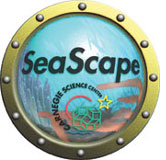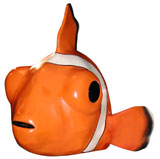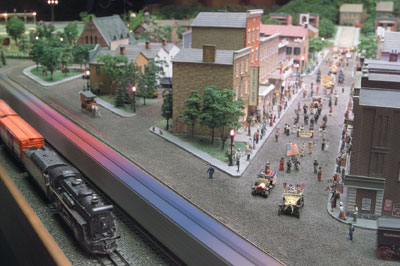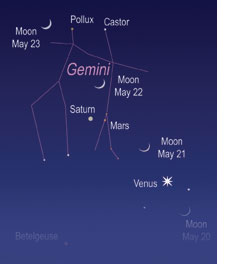NASCAR: The IMAX Experience
It seems impossible, but there’s
actually a way to participate in the Daytona 500 race—at
speeds up to 200 miles per hour—without having
to buckle a seatbelt or wear a safety helmet. It’s
called NASCAR: The IMAX Experience. Going 65 mph on
the Parkway was never like this.
At Carnegie Science
Center’s Rangos Omnimax Theater,
this thrill-ride of a movie puts a camera in the
driver’s
seat for an intense, up-close-and-personal look into
the terrors and unpredictability of auto racing.
With more than 75 million fans, NASCAR
is considered one of the United States’ most
popular spectator sports and NASCAR: The IMAX Experience
explains what
the noise is all about. Filmed on location at a
number of racetracks and racing events (including the
45th
Daytona 500 and the Bristol Motor Speedway) as
well as various testing environments and NASCAR’s
new, state-of-the-art research center in Concord,
North Carolina, NASCAR: The IMAX Experience introduces
audiences
to the drivers, support crews, and even the rabid
fans. In addition, the film explores the technology
that keeps the cars on the track, the physics the drivers
depend on to successfully
navigate
the track and maneuver within inches of their competitors,
and the minds of the individuals who compete for
the coveted checkered flag. NASCAR: The IMAX
Experience
also takes a glimpse into the rearview mirror at
the sport’s 56-year
history.
Thanks to the four-story-tall screen
and surround sound speakers, NASCAR: The IMAX Experience provides
viewers
an opportunity to feel what racing is like. Scenes
filmed inside the cars—including footage
of some awesome collisions and car flips—will
have audience members stomping on the floor looking
for the brake
pedal.
Paul Brooks, president of NASCAR Digital
Entertainment, says: “Very few people will
ever be able to experience what it’s like
to drive and compete at more than 200 miles per
hour with the precision and skill that
NASCAR drivers achieve. This film allows us to
immerse an audience in the NASCAR experience.”
Narrated by Keifer Sutherland and directed
by Simon Wincer, NASCAR: The IMAX Experience
will
put fans—and
those new to the sport—on the edges of
their seats, begging the filmmakers to slow
it down.
After NASCAR takes its final lap,
the Rangos
Omnimax Theater presents a thrill
ride of a different kind: James Cameron’s documentary
Ghosts of the Abyss, a look at the fate of the Titanic,
opening October 1. OMNIMAX® tickets are $8 for
adults and $6 for children and seniors who are non-members,
and $7 for adults and $5 for children and seniors who
are members. Or, OMNIMAX tickets can be purchased for
an additional $5 with general admission. For information
on show times and additional movie titles, visit www.carnegiesciencecenter.org
or call 412.237.3400.

FEATURED FAVORITE
The
SeaScape at Carnegie Science Center
Still looking for Nemo? Maybe he’s hiding out
at Carnegie Science Center’s 2,000-square-foot
SeaScape aquarium, the home to fish and creatures of
every size and color. And some just have to be seen
to be believed.
 Three creatures are relatively new to
SeaScape. The Cassiopeia jellyfish (a.k.a. the upside
down jellyfish),
located on the floors of the lagoon and mangrove
tanks, have photosynthetic algae living inside their
center
tentacles. The sea apple, a type of sea cucumber
residing near the back reef, is bright purple with
red highlights,
yellow tube feet, and inch-long tentacles. And the
fore reef has recently welcomed the squareblock anthius—the
male is a stunning bright-pinkish-orange color with
an unusual square pinkish-lavender spot; the female
is orange with red spots. Three creatures are relatively new to
SeaScape. The Cassiopeia jellyfish (a.k.a. the upside
down jellyfish),
located on the floors of the lagoon and mangrove
tanks, have photosynthetic algae living inside their
center
tentacles. The sea apple, a type of sea cucumber
residing near the back reef, is bright purple with
red highlights,
yellow tube feet, and inch-long tentacles. And the
fore reef has recently welcomed the squareblock anthius—the
male is a stunning bright-pinkish-orange color with
an unusual square pinkish-lavender spot; the female
is orange with red spots.
All components of a Pacific
Coral Reef ecosystem—fore
reef, back reef, lagoon, and mangrove (with actual
mangrove trees)—have been recreated in SeaScape’s
interconnected, five-tank system. In the coral
reef area, a refuge serves as a man-made nursery
to keep
predators at a safe distance while baby animals
mature, and the algal scrubber works as the biological
filter
to clean the seawater of waste and supply oxygen.
On the algal scrubber, algae are grown on screens
to provide
a natural filter for the coral reef. It is one
of only a few such natural filtration systems being
used for
public exhibits in the United States.
Interactive
computer stations, colorful images,
video clips, sound effects, and audio narration
provide
in-depth information on some of the more than
400 species of
plants and animals living in this 1,800-gallon
coral reef ecosystem. Eight underwater camera
stations allow visitors to zoom in for a closer look
at
the
bizarre-looking
corals, algae, plants, and tongue-twistingly
named animals such as the Knysna Seahorses, Bi-Color
Parrot Fish, Clownfish, Flame Angels, Lawnmower
Blennies,
and Magenta Dottybacks.
A yellow submarine is
available for the kids to “explore” a
replica of a sunken ship’s bow, and a 150-gallon
touch tank provides the curious with an up-close
look at several varieties of sea creatures, including
starfish
and horseshoe crabs. And, if the fish aren’t
surreal enough, the See Like a Fish exhibit—two
periscopes mounted inside a larger-than-life
model clownfish head—presents anyone sticking
their head inside with a fish-eyed view of the
world.
SeaScape at Carnegie Science Center is sponsored by 
Running better,and always on
time, after 50 years.
The Miniature Railroad & Village®

This promises to be a big year for Carnegie Science
Center’s Miniature Railroad & Village: On
December 1, 2004, the beloved 2,300-square-foot exhibit
celebrates the 50th anniversary of its first appearance
at the Buhl Planetarium and Institute of Popular Science.
While most of the celebrations are scheduled for later
in the year, two special events will occur this summer.
Debuting in late June 2004 and running through July
2007, a new inter-active exhibit highlighting the
technology and ongoing science of railroad engineer-ing
will be
located in the alcoves outside the Miniature Railroad
display. Created by Pittsburgh’s own Union Switch & Signal
(founded in 1881 by George Westinghouse), the exhibit
complements the Miniature Railroad & Village with
interactive displays on the need for fail-safe signaling;
the advantages of computer-controlled signaling; the
management of rail traffic patterns; train routing;
and careers in the train switch/signal industry. Another
display highlights the history of Union Switch & Signal. “
The Miniature Railroad & Village is so realistic,
but you never think about how the trains are run, how
they stay on the tracks, and the science behind it
all,” says Tom Meston, Union Switch & Signal’s
manager of marketing communications. Meston, who grew
up visiting the exhibit with his family, is thrilled
by the partnership between Union Switch & Signal
and the Miniature Railroad & Village.
 The technology of railroad signals is featured
in a special exhibit. The technology of railroad signals is featured
in a special exhibit.
“This exhibit will provide a better understanding—to
both kids and adults—of the technology behind
the industry. This is a great opportunity to reach
the Pittsburgh community and explain how this technology
works,” Meston says.
In June, members of the
Train Collectors Association will visit Pittsburgh
for their 50th anniversary
national convention. The convention will include
two tours
of the Miniature Railroad & Village on June 22 and June 24. And it’s
a pretty good bet that all those miniature train enthusiasts will be standing
in line for
the 50th Anniversary Boxcar, which will be available at the XPLOR store
later
this year.
Dance of the Planets
By
John G. Radzilowicz, director of the Henry Buhl,
Jr. Planetarium and Observatory
 On Saturday and Sunday, April 3-4, 2004 visitors can
join the staff of Carnegie Science Center’s Henry
Buhl, Jr. Planetarium & Observatory along with
members of the Amateur Astronomers Association of Pittsburgh
for a two-day celebration of Astronomy and Space Science! On Saturday and Sunday, April 3-4, 2004 visitors can
join the staff of Carnegie Science Center’s Henry
Buhl, Jr. Planetarium & Observatory along with
members of the Amateur Astronomers Association of Pittsburgh
for a two-day celebration of Astronomy and Space Science!
Pittsburgh’s
astronomical weekend grew out of a grass roots “Astronomy
Day” event that
started in 1973. For 30 years now, professional and
amateur astronomers have joined forces to share the
joy of astronomy with as many people as possible
during these special events. During these astronomical
festivals,
hundreds of thousands of people around the world
will have an opportunity to see firsthand what has
so many
astronomers excited. Astronomy clubs, science centers,
observatories, planetariums, universities, and nature
centers worldwide host gatherings and activities
to acquaint their visitors with local astronomical
resources
and facilities—all to help bring the universe
a little closer.
Astronomical celebrations will take
place at hundreds of sites across the United States.
Internationally,
England, Canada, New Zealand, Finland, Sweden,
the Philippines, Argentina, Malaysia, New Guinea, and
many other countries are hosting activities. Each
location
plans and executes special events that work best
for their local community.
So, what can visitors
expect? At Carnegie Science Center, visitors will
be able to fly to the far
reaches of
the Cosmos in the Planetarium, launch model rockets
along the Ohio River, study the Sun, Moon, and
stars from the rooftop Observatory and get a
close-up look
at meteorites and Moon rocks. They will learn
about the latest news from Mars and explore the universe
around us through shows, lectures, workshops,
and
lots of hands-on fun. Activities are geared for
all ages
and interest levels.
Whether you’re interested
in learning how to find your way among the
stars, checking out the latest
and greatest telescopes, hearing about the
latest astronomical news, or exploring life aboard
the
International Space
Station, this weekend is for you!
Back to Contents |